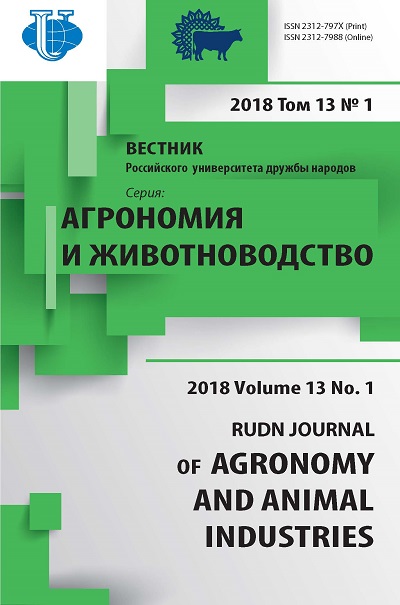The studies of the reaction to the salt stress of varieties of fodder crops for formation of pastures in the conditions of North Western Caspian
- Authors: Puchkov MY.1, Lysakov MA1, Tumanyan AF2, Loktionova EG3, Strukov VM1, Terekhin AA2
-
Affiliations:
- All-Russian Scientific Research Institute of Irrigation Vegetable and Melon Crop
- Рeoples’ Friendship University of Russia (RUDN University)
- Astrakhan State University
- Issue: Vol 13, No 1 (2018)
- Pages: 26-34
- Section: Crop production
- URL: https://agrojournal.rudn.ru/agronomy/article/view/18080
- DOI: https://doi.org/10.22363/2312-797X-2018-13-1-26-34
- ID: 18080
Cite item
Full Text
Abstract
On the territory of the North-Western Caspian, significant areas occupy soils with varying degrees of salinity, therefore, to form pastures in these areas, it is necessary to select species and varieties of crops that tolerate salt stress. We conducted expeditionary studies on the study of floristic composition, as well as phenological, biometric observation and thoroughly studied the soil cover of pasture communities. As a result, plant species from these communities were selected, which were the most adapted to the unfavorable conditions of the Northwest Caspian region, and other species and cultivars were added from the world collection of All-Union Scientific Research Institute of Plant Growing of other ecogeographical regions. Expeditionary research on the selection of species of pasture plants was carried out on the territory of the West Ilmenno-hillock landscape area, and laboratory studies in the laboratory of the All-Russian Research Institute of Veterinary Research in the period 2011-2017. The purpose of the study is to select varieties and species of perennial pasture crops that are most resistant to high salt content in the soil. When studying the ability of species and varieties to tolerate salt stress, plants were isolated according to their fitness for stress. The most adapted plants, where the percentage of viable seeds was from 24% to 30%, the average ability to tolerate salt stress with germination in seeds of 15%, and varieties and species with an germination from 0.1% to 0% - are unsuitable. To very adapted to salt stress include species and varieties of the plant: Elytrigia elongate (Host.) Nevski, var. Salt - 30%; Elymus novae-angliae (Scribn.) Tzvelev) Ozernensky variety - 28%; elongated elm (Elytrigia elongate (Host.) Nevski) variety Stavropol 10 - 28%; elongated elm (Elytrigia elongate (Host.) Nevski) sort Argonaut - 27%; Agropyron pectinatum (M. Bieb.) Variety - 26%, Bromopsis inermis (Leyss.) Holub, cultivar Stavropol 31 - 24%.
About the authors
M Yu Puchkov
All-Russian Scientific Research Institute of Irrigation Vegetable and Melon Crop
Author for correspondence.
Email: rosecostroi@mail.ru
доктор сельскохозяйственных наук, доцент, директор Всероссийского научно-исследовательского института орошаемого овощеводства и бахчеводства
Lubich st., 16, Kamyzyak, Astrakhan Region, Russia, 416341M A Lysakov
All-Russian Scientific Research Institute of Irrigation Vegetable and Melon Crop
Email: nature1986@yandex.ru
научный сотрудник Всероссийского научно-исследовательского института орошаемого овощеводства и бахчеводства
Lubich st., 16, Kamyzyak, Astrakhan Region, Russia, 416341A F Tumanyan
Рeoples’ Friendship University of Russia (RUDN University)
Email: aftum@mail.ru
доктор сельскохозяйственных наук, профессор Агробиотехнологического департамента Аграрнотехнологического института Российского университета дружбы народов
Miklukho-Maklaya st., 6, Moscow, Russia, 117198E G Loktionova
Astrakhan State University
Email: eleloktionova@yandex.ru
кандидат химических наук, доцент кафедры экологии, природопользования, землеустройства и безопасности жизнедеятельности Астраханского государственного университета
Shaumyan sq., 1, Astrakhan, Russia, 414000V M Strukov
All-Russian Scientific Research Institute of Irrigation Vegetable and Melon Crop
Email: nature1986@yandex.ru
младший научный сотрудник Всероссийского научно-исследовательского института орошаемого овощеводства и бахчеводства
Lubich st., 16, Kamyzyak, Astrakhan Region, Russia, 416341A A Terekhin
Рeoples’ Friendship University of Russia (RUDN University)
Email: terekhin_aa@rudn.university
кандидат сельскохозяйственных наук, доцент Агробиотехнологического департамента Аграрно-технологического института Российского университета дружбы народов
Miklukho-Maklaya st., 6, Moscow, Russia, 117198References
- Diagnostics of plant resistance to stress: Methodological guidance. Team of authors. L.: VIR, 1988. 228 p.
- Kosolapov V.M. Genetic resources of fodder production. Bulletin of the Russian Academy of Sciences. 2015. Vol. 85, No. 1. P. 19—22.
- Lysakov M.A. The system of ecological strategies of plants of Ramensky-Grime for the formation of a sustainable plant community on the degraded landscapes of the North-Western Caspian Region. Natural sciences. 2015. No. 3. (52).
- Puchkov M.Yu. Lokokolosnik Sitnikov in desert agrocenoses of the North-Western Pre-Caspian Region. Natural sciences. 2014. № 3. P. 18—21.
- Puchkov M.Yu. New varieties of perennial grasses for the arid zone of the Northern Caspian. Adaptive fodder production. 2013. No. 1 (13). P. 50—53.
- Shakhmedov I.Sh. Selection of varieties of perennial grasses for cultivation on saline and degraded pastures in the Northern Caspian Region. Theoretical and applied problems of the agro-industrial complex. 2016. № 2 (27). P. 14—17.
- Puchkov M.Y., Loktionova E.G., Puchkova A.M., Yakovleva L.V., Andrianov V.A., Lysakov M.A. Use Of Geosynthetic Nonwoven Roll Material for the Restoration of the Natural and Technogenic Systems. Abstract International Journal of Applied Engineering. 2015. Vol. 10. N 12. P. 29083—29089.
- Kikvidze Z., Brooker R.W., Butterfield B.J., Callaway R.M., Cavieres L.A. The effects of foundation species on community assembly: a global study on alpine cushion plant communities. Ecology. 2015. 96 (8), 2064—2069.
- Sotomayor D.A., Lortie C.J. Indirect interactions in terrestrial plant communities: emerging patterns and research gaps. Ecosphere. 2015. 6 (6), art103.
- Sotomayor D.A., Lortie C.J., Lamarque L.J. Nurse‐plant effects on the seed biology and germination of desert annuals. Austral Ecology. 2014. 39 (7), 786—794.
- Michalet R., Maalouf J.P., Choler P., Clément B., Rosebery D., Royer J.M. Competition, facilitation and environmental severity shape the relationship between local and regional species richness in plant communities. Ecography. 2014. 37, 1—11.
- Thébault A., Mariotte P., Lortie C.J. Land management trumps the effects of climate change and elevated CO2 on grassland functioning AS MacDougall Journal of Ecology. 2014. 102 (4), 896—904.
- Violle C., Choler P., Borgy B., Garnier E., Amiaud B., Debarros G., Diquelou S. Vegetation ecology meets ecosystem science: Permanent grasslands as a functional biogeography case study. Science of The Total Environment, 2015.
Supplementary files















